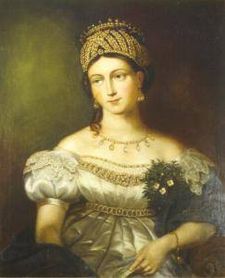- Princess Louise of Saxe-Gotha-Altenburg (1800–1831)
-
For her grandmother, the Duchess consort of Mecklenburg-Schwerin, see Princess Louise of Saxe-Gotha-Altenburg (1756–1808).
Louise of Saxe-Gotha-Altenburg Duchess consort of Saxe-Coburg-Saalfeld 
Painting by William Corden, 1844 known as William Corden the Elder (1795-1867) Consort 1817–1826 Spouse Ernst I, Duke of Saxe-Coburg and Gotha Issue Ernest II, Duke of Saxe-Coburg and Gotha
Albert, Prince Consort of the United KingdomFull name Louise Dorothea Pauline Charlotte Fredericka Auguste House House of Saxe-Gotha-Altenburg
House of Saxe-Coburg and GothaFather Augustus, Duke of Saxe-Gotha-Altenburg Mother Louise Charlotte of Mecklenburg-Schwerin Born 21 December 1800
GothaDied 30 August 1831 (aged 30)
ParisBurial Burials at the Ducal Family Mausoleum, Glockenburg Cemetery, Coburg Princess Louise of Saxe-Gotha-Altenburg (Louise Dorothea Pauline Charlotte Fredericka Auguste; 21 December 1800 – 30 August 1831) was the wife of Ernst I, Duke of Saxe-Coburg and Gotha and the mother of Duke Ernst II and Prince Albert, husband of Queen Victoria.
Contents
Family
Princess Louise was the only daughter of Augustus, Duke of Saxe-Gotha-Altenburg and his first wife Louise Charlotte of Mecklenburg-Schwerin, daughter of Frederick Francis I, Grand Duke of Mecklenburg-Schwerin and Princess Louise of Saxe-Gotha-Altenburg (her namesake).
Marriage and issue
On 31 July 1817 in Gotha, sixteen-year old Louise married her thirty-three year old kinsman Ernst I, Duke of Saxe-Coburg-Saalfeld after he failed to win the hand of a Russian grand duchess.[1] Louise was considered "young, clever, and beautiful".[2]
They had two children: Ernst, who inherited his father's lands and titles, and Albert, who was later the husband of Queen Victoria.
The marriage was unhappy because of Ernst's infidelities and the couple separated in 1824. St. Wendel, in the Principality of Lichtenberg, was assigned as her new residence and Louise was forced to leave her two sons behind. Biographer Lytton Strachey noted in 1921: "The ducal court was not noted for the strictness of its morals; the Duke was a man of gallantry, and it was rumoured that the Duchess followed her husband's example. There were scandals: one of the Court Chamberlains, a charming and cultivated man of Jewish extraction, was talked of; at last there was a separation, followed by a divorce."[3]
Post-divorce
On 31 March 1826 their marriage was officially dissolved. Seven months later, on 18 October 1826, Louise secretly married in St. Wendel her former lover, the Baron Alexander von Hanstein (later created Count of Pölzig and Beiersdrof). In her previous marriage, she had taken great interest in the social life of the principality and was revered as its Landesmutter (literally, "mother of the region"). Nevertheless, this happy life ended in February 1831, when her secret marriage to von Hanstein was discovered and she lost her children permanently.
Louise died of cancer on 30 August 1831, when she was only 30 years old. Years after her death, Queen Victoria described Louise in a 1864 memorandum: "The princess is described as having been very handsome, though very small; fair, with blue eyes; and Prince Albert is said to have been extremely like her".[4]
References
Sources
- Grey, Hon. Charles (1868). The Early Years of His Royal Highness The Prince Consort. New York: Harper & Brothers Publishers. http://books.google.com/books?id=pCU2AAAAMAAJ&printsec=frontcover&dq=The+Early+Years+of+His+Royal+Highness+The+Prince+Consort.&hl=en&ei=PiKJTNW_IpWpngfZoOXQDA&sa=X&oi=book_result&ct=result&resnum=1&ved=0CCsQ6AEwAA#v=onepage&q&f=false.
- Weintraub, Stanley (1997). Uncrowned King: The Life of Prince Albert. London: John Murray Inc.. ISBN 0719557569. http://books.google.com/books?id=4Z1S6CSXV2UC&printsec=frontcover&dq=stanley+weintraub+albert+uncrowned+king&source=bl&ots=8VSLNVsPpN&sig=yuENiClwpDKwvGWUVQD_FnhPyqY&hl=en&ei=W9KHTPrpEsKFnQex49WlCw&sa=X&oi=book_result&ct=result&resnum=1&ved=0CBIQ6AEwAA#v=onepage&q&f=false.
External links
 Media related to Louise of Saxe-Gotha-Altenburg at Wikimedia Commons
Media related to Louise of Saxe-Gotha-Altenburg at Wikimedia Commons
Princess Louise of Saxe-Gotha-Altenburg (1800–1831)Cadet branch of the House of WettinBorn: 21 December 1800 Died: 16 November 1831German royalty Vacant Title last held byAugusta of Reuss-EbersdorfDuchess consort of Saxe-Coburg-Saalfeld
31 July 1817 – 31 March 1826Succeeded by
Duchess Marie of Württemberg
as Duchess of Saxe-Coburg and GothaThe generations indicate descent from Bernhard I, the first Duke of Saxe-Gotha-Altenburg and founder of the Saxe-Gotha-Altenburg line.1st Generation Anna Sophie, Princess of Schwarzburg-Rudolstadt • Princess Magdalene Sibylle • Dorothea Marie, Duchess of Saxe-Meiningen • Fredericka, Princess of Anhalt-Zerbst • Princess Elisabeth • Johanna, Duchess of Mecklenburg-Strelitz2nd Generation Princess Sophie • Princess Sophie • Fredericka, Duchess of Saxe-Weissenfels • Princess Magdalena Sibylle • Augusta, Princess of Wales3rd Generation Princess Fredericka Louise • Princess Sophie • Augusta, Princess of Schwarzburg-Rudolstadt • Louise, Duchess of Mecklenburg-Schwerin4th Generation none5th Generation Louise, Duchess of Saxe-Coburg-Saalfeld
Categories:- Princesses of Saxe-Gotha-Altenburg
- 1800 births
- 1831 deaths
- Burials at the Ducal Family Mausoleum, Glockenburg Cemetery, Coburg
- Duchesses of Saxe-Coburg-Saalfeld
- House of Saxe-Coburg and Gotha
- House of Saxe-Gotha-Altenburg
- People from Gotha
- Deaths from cancer
Wikimedia Foundation. 2010.
